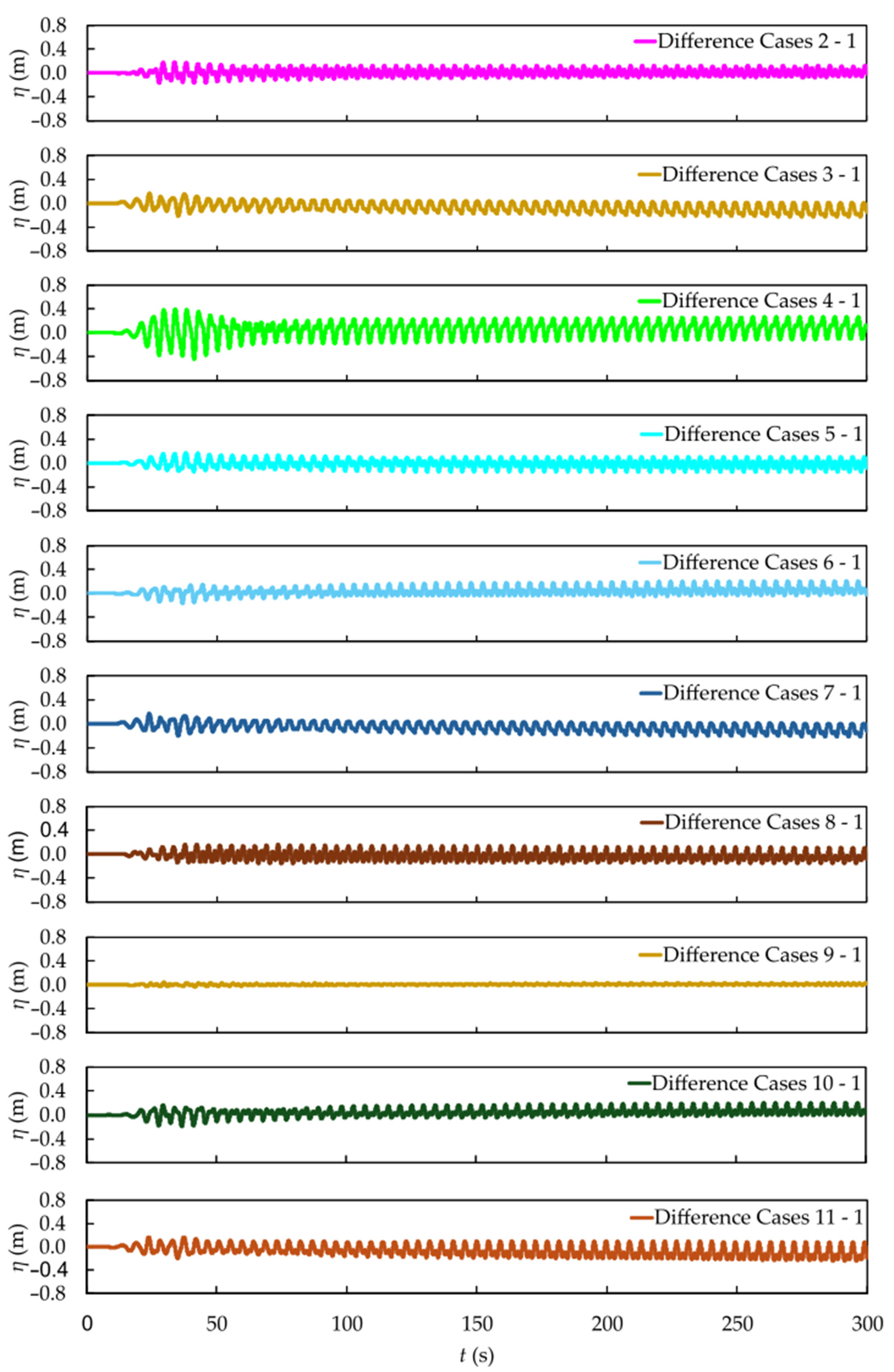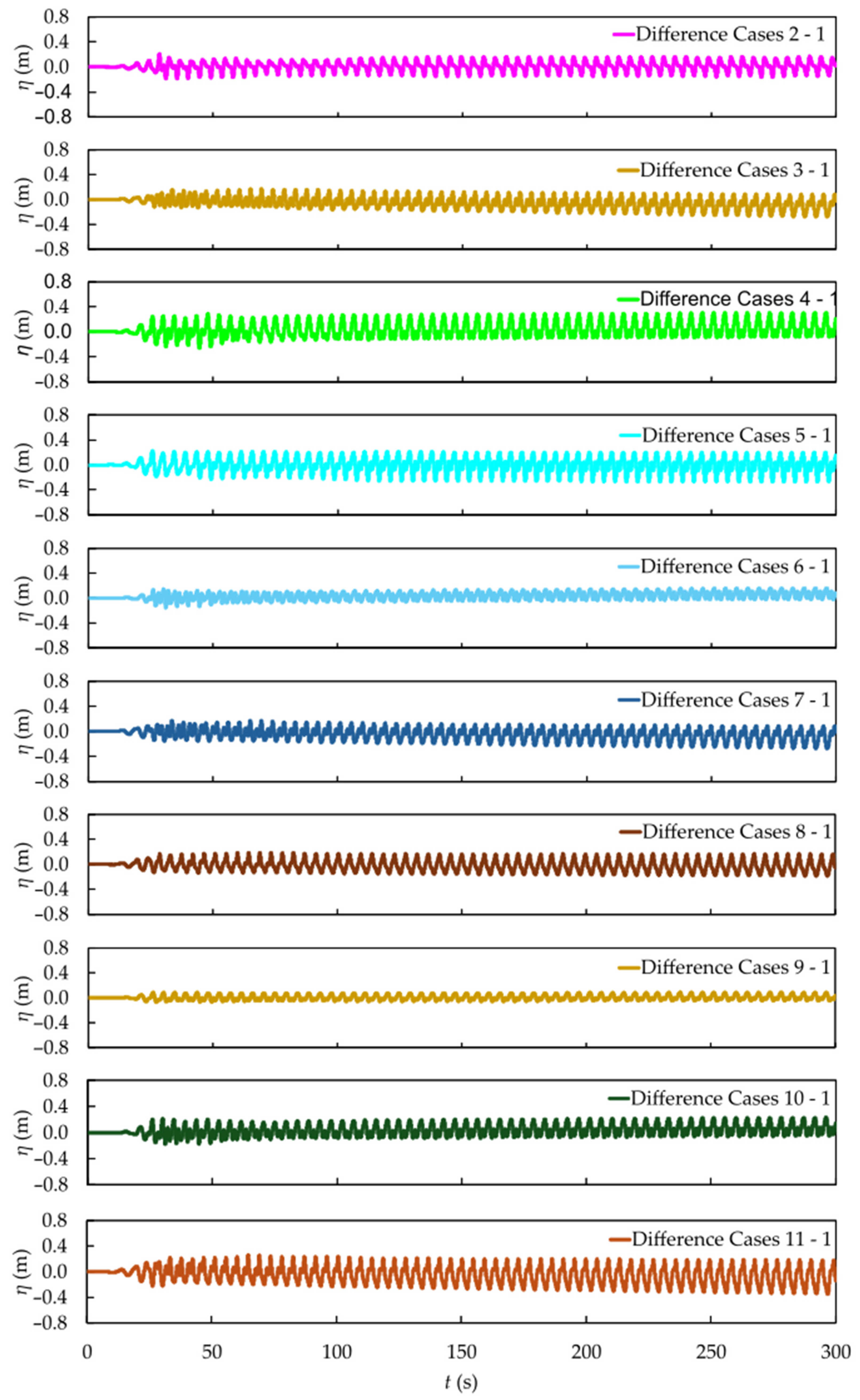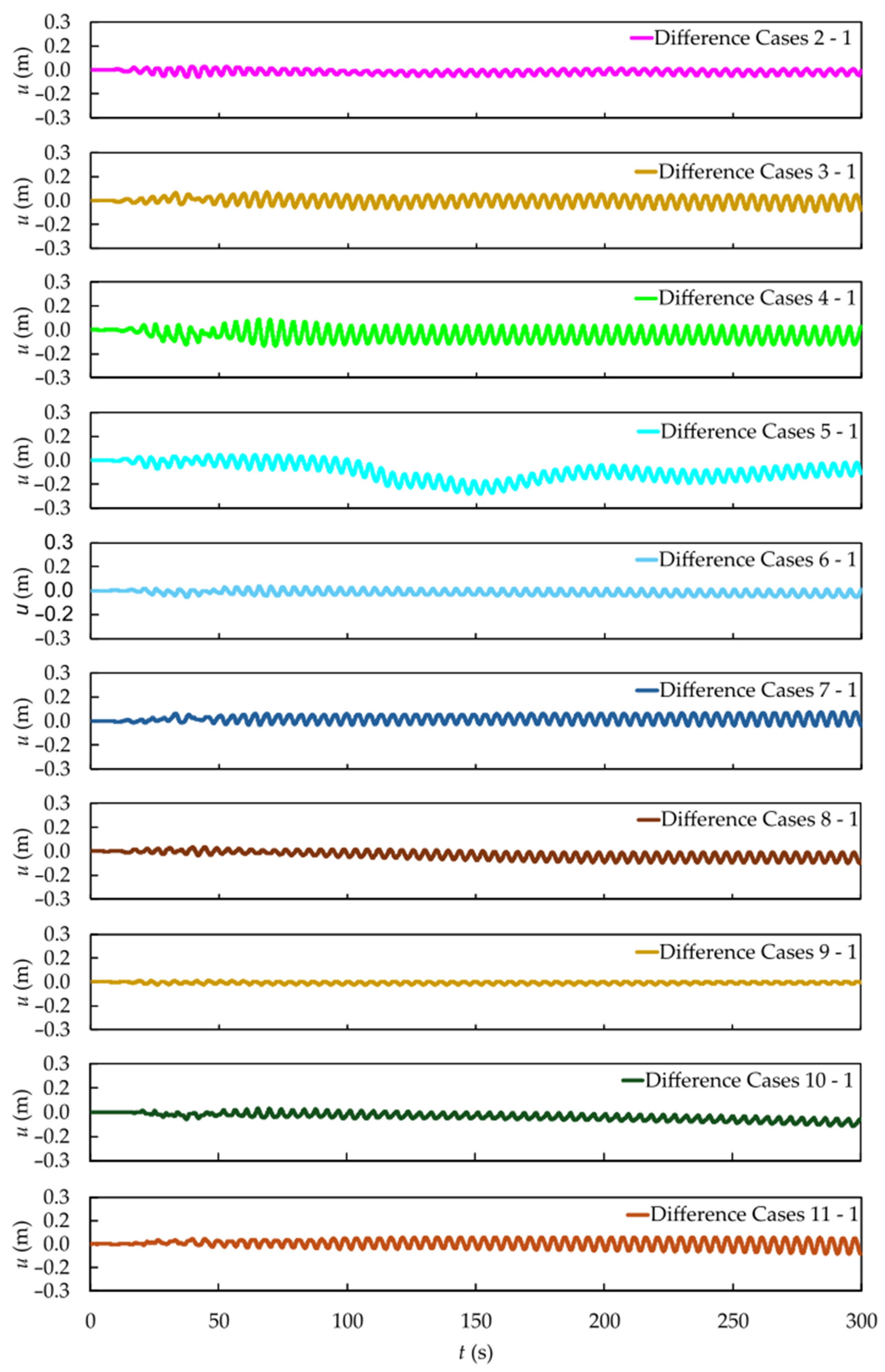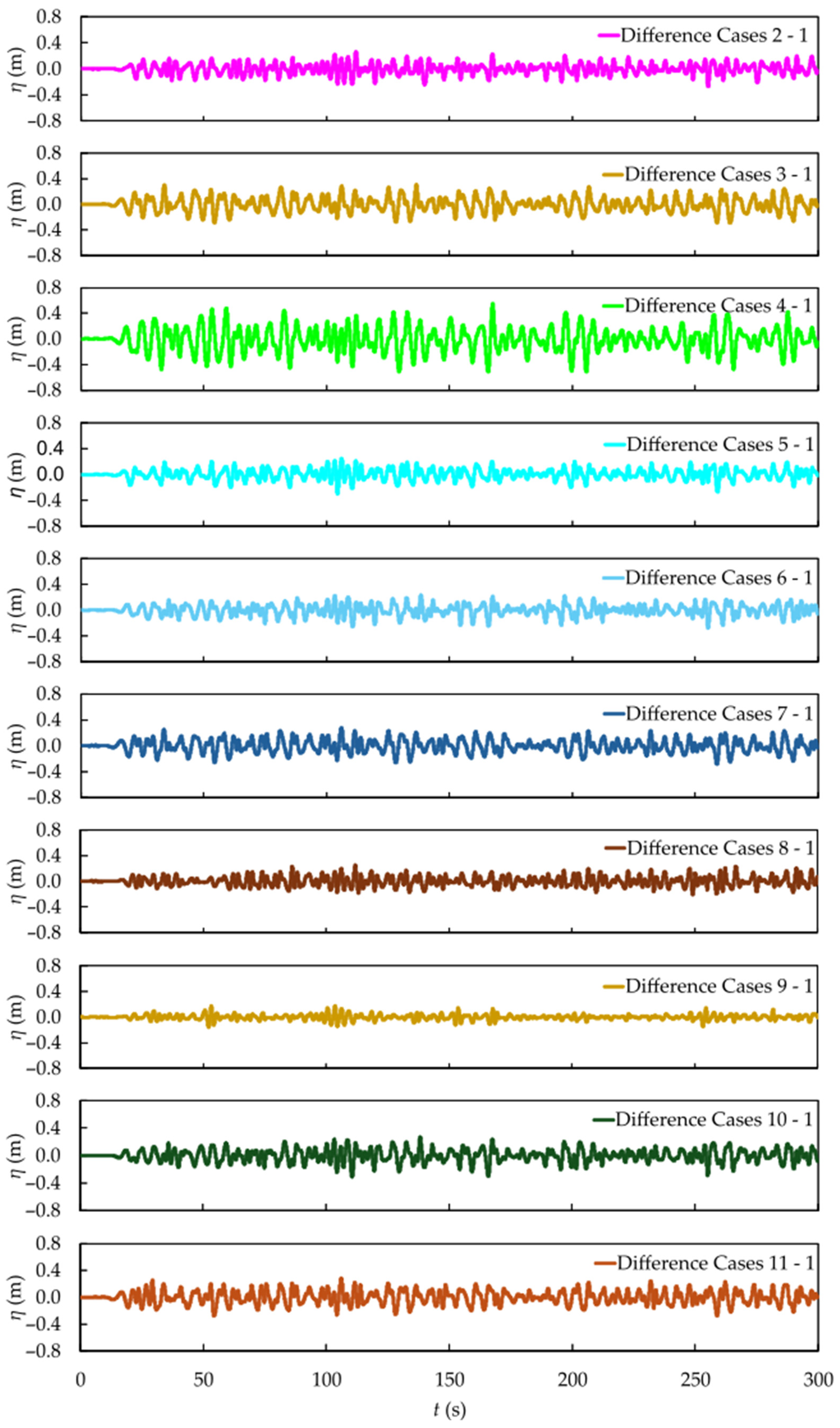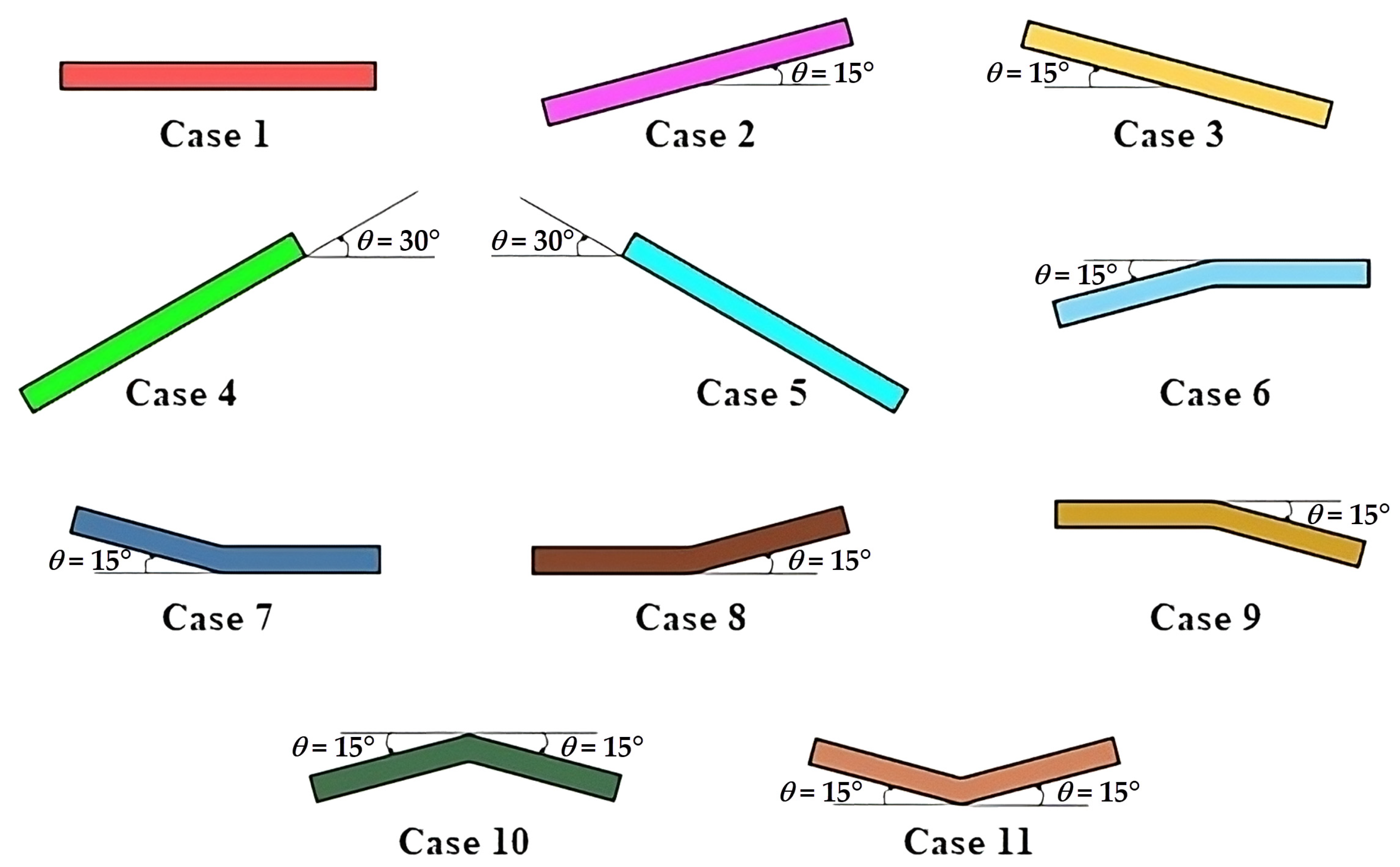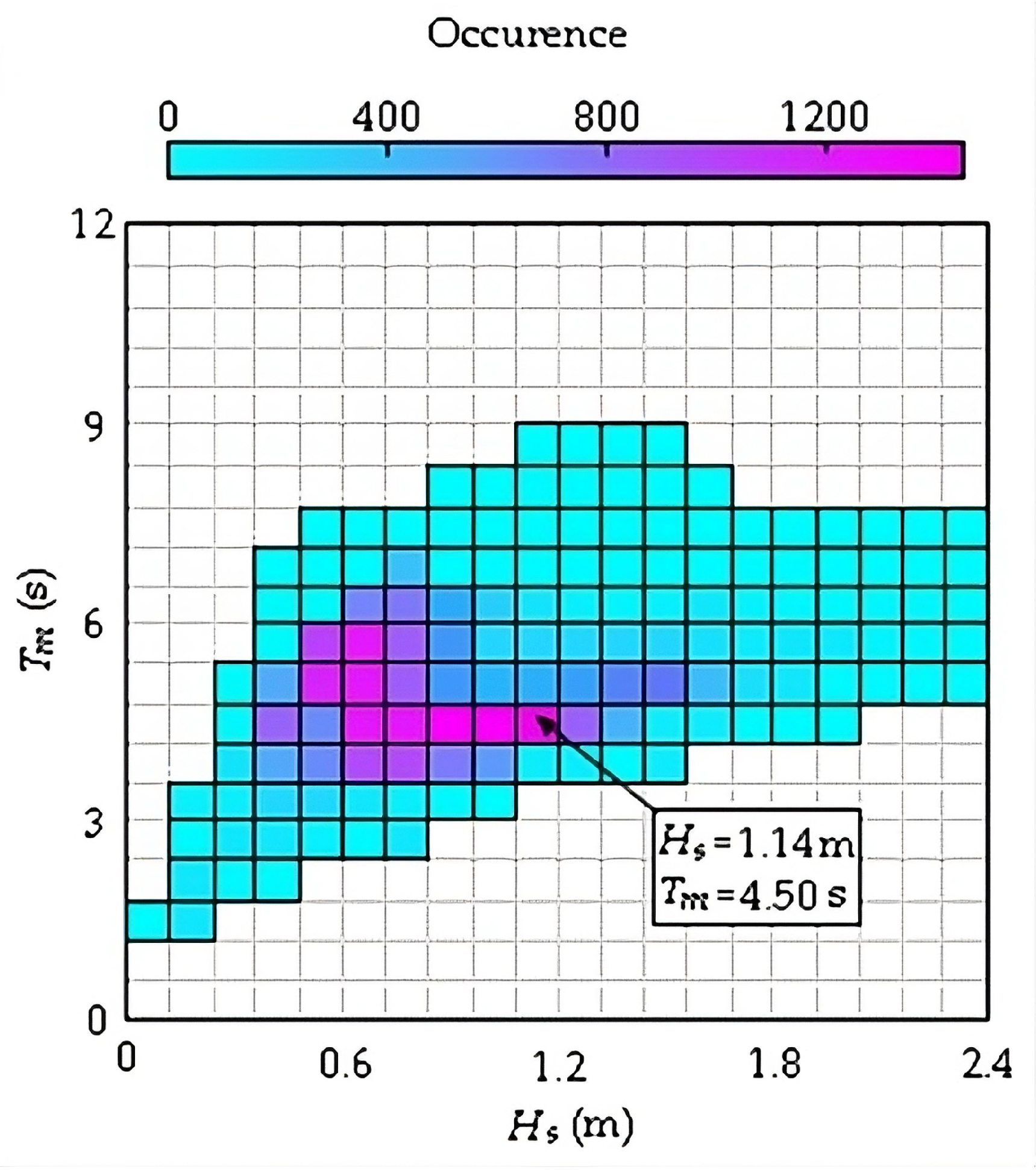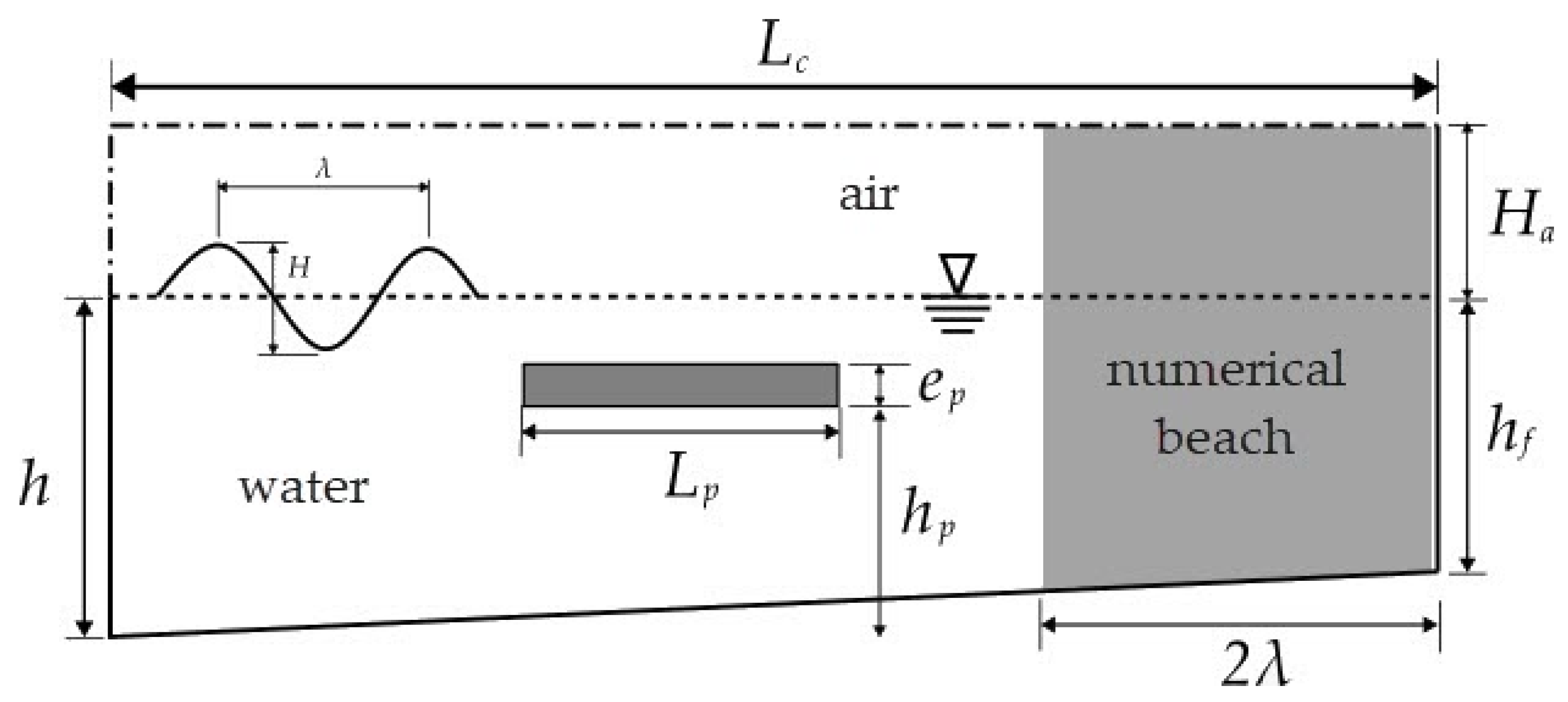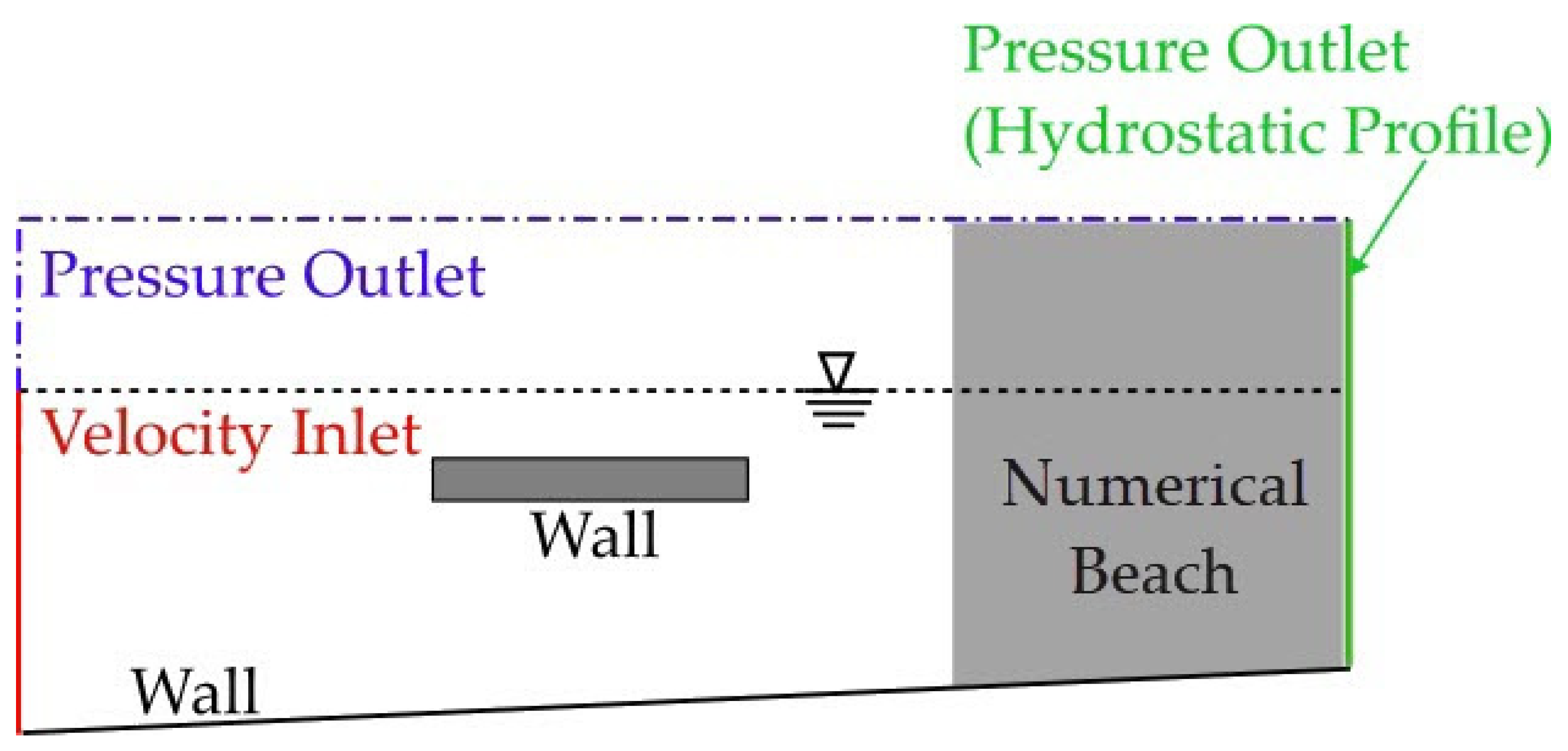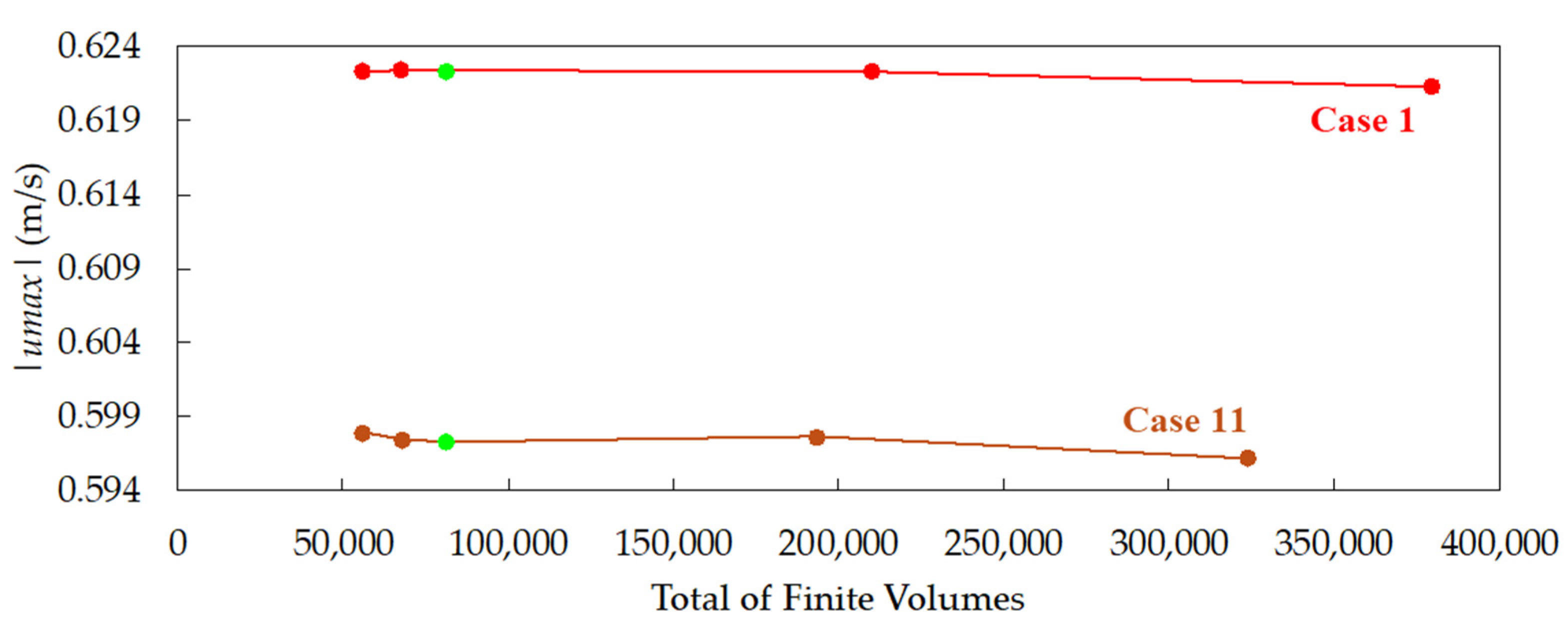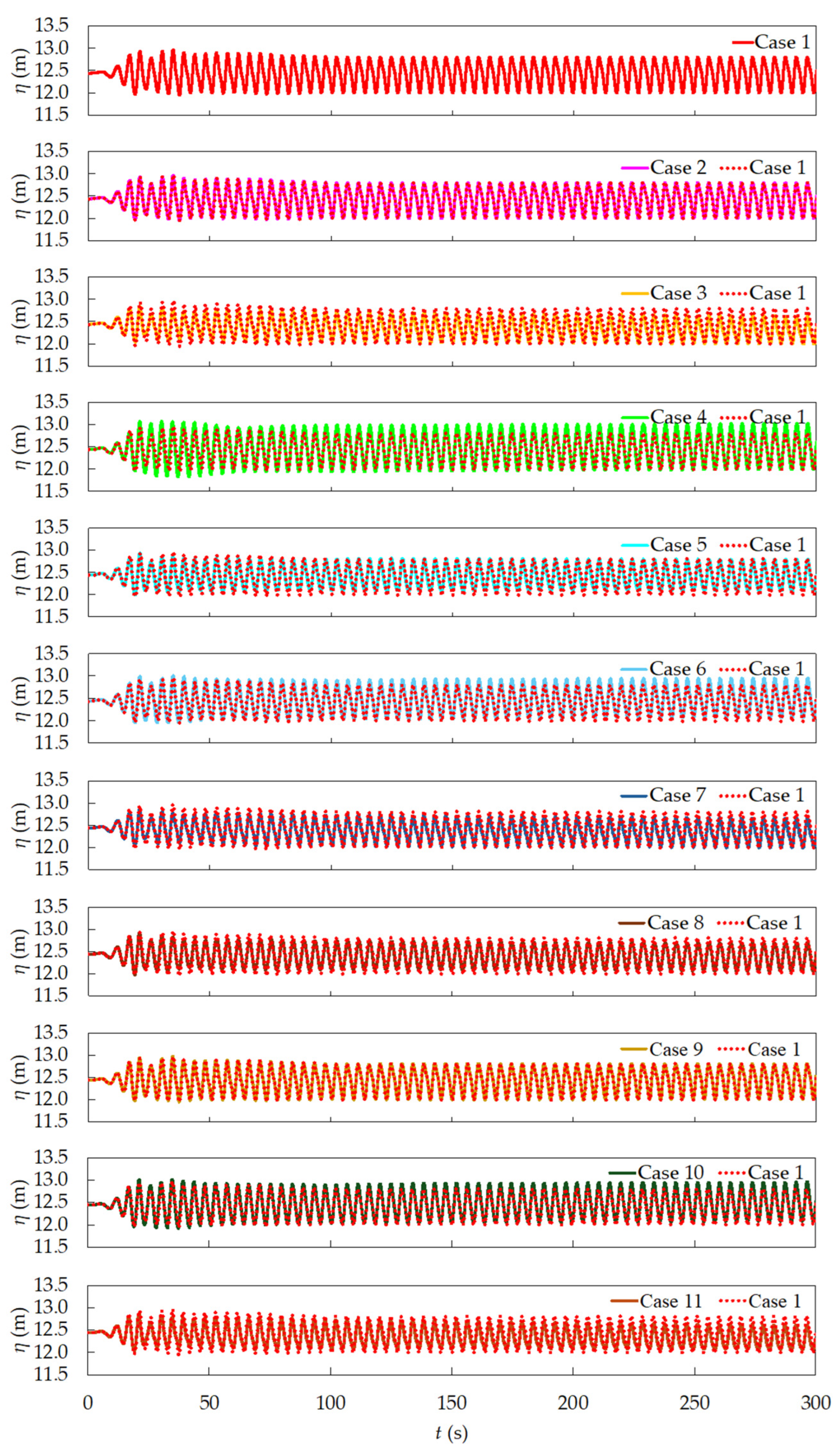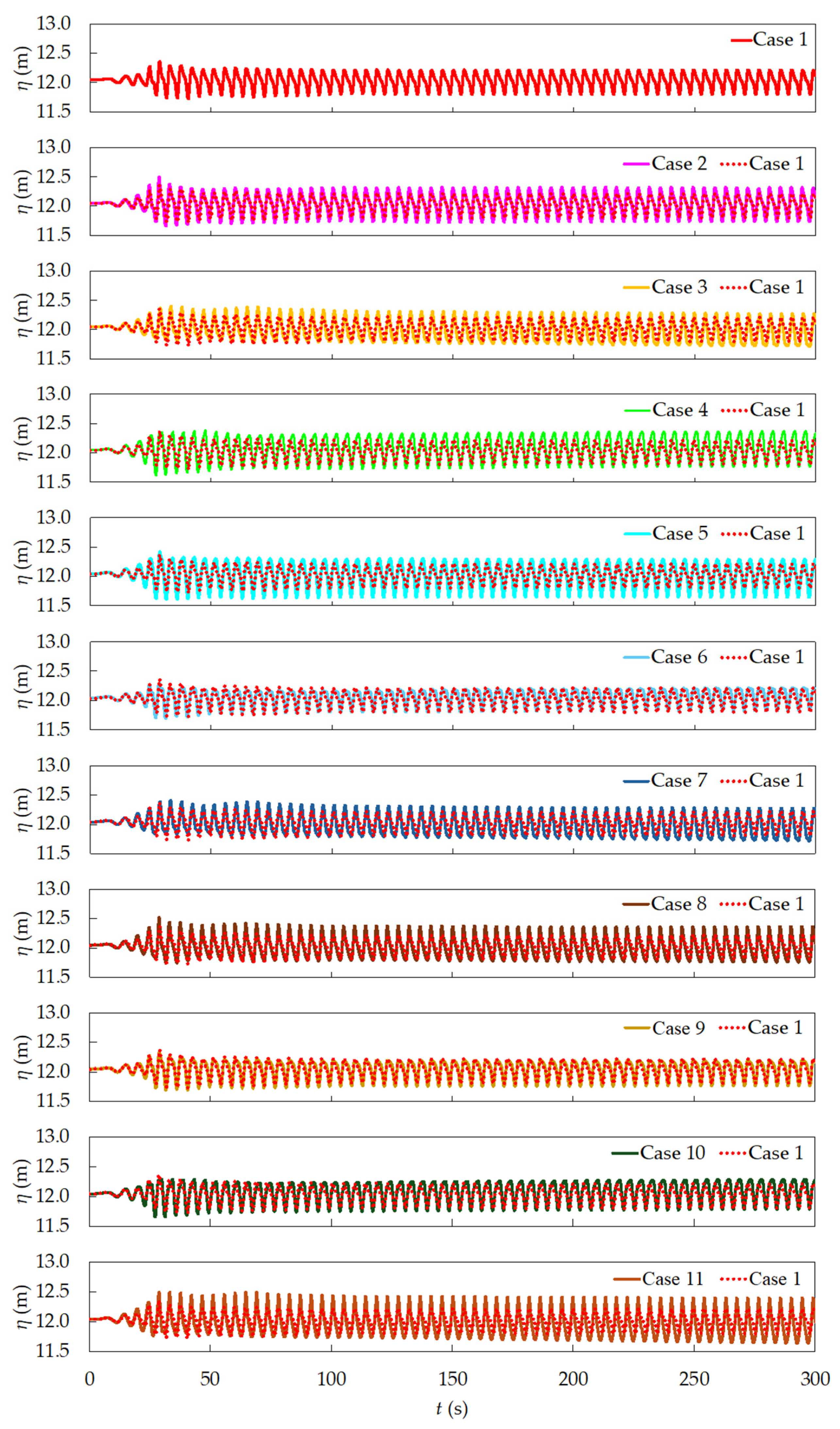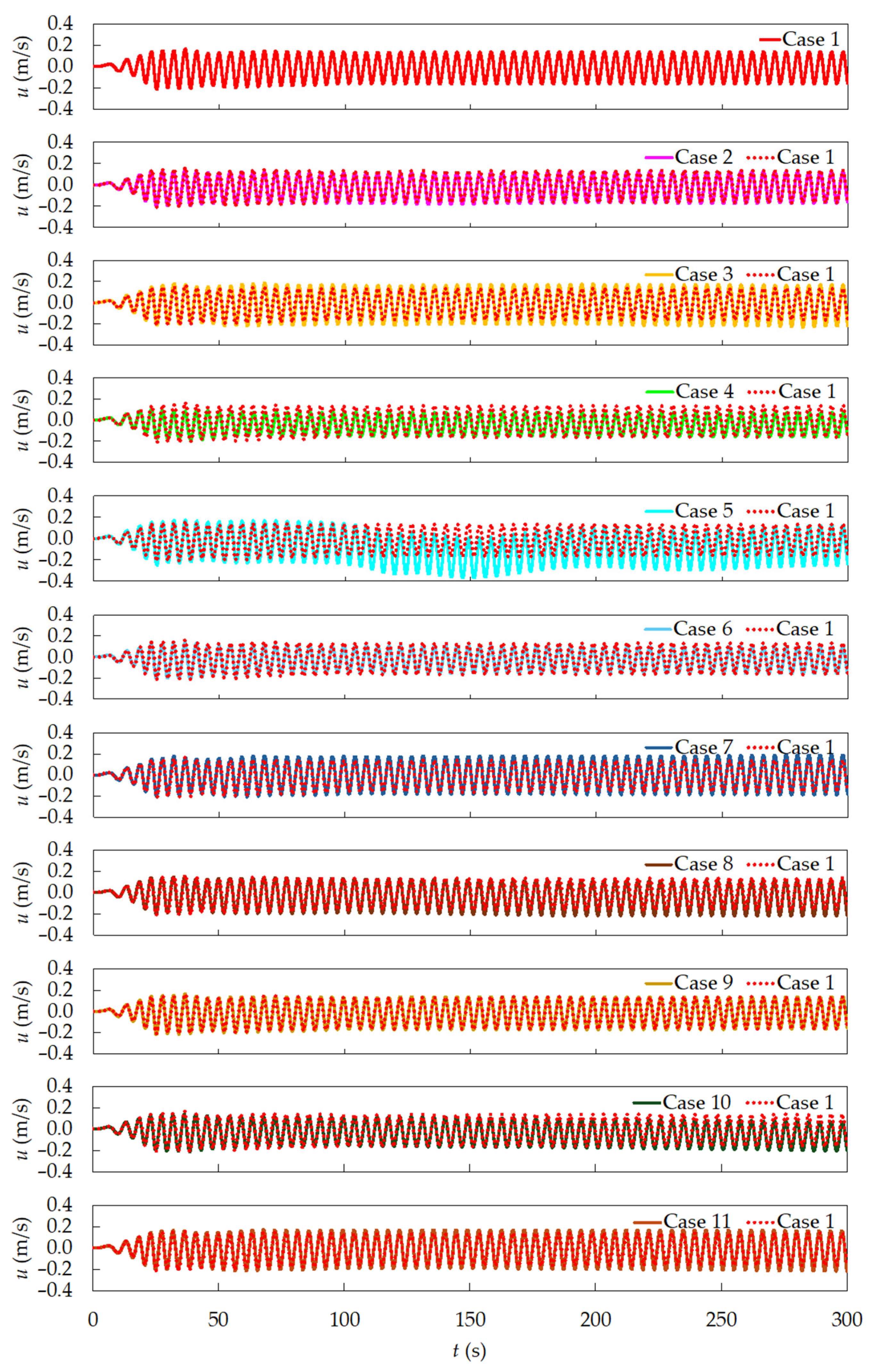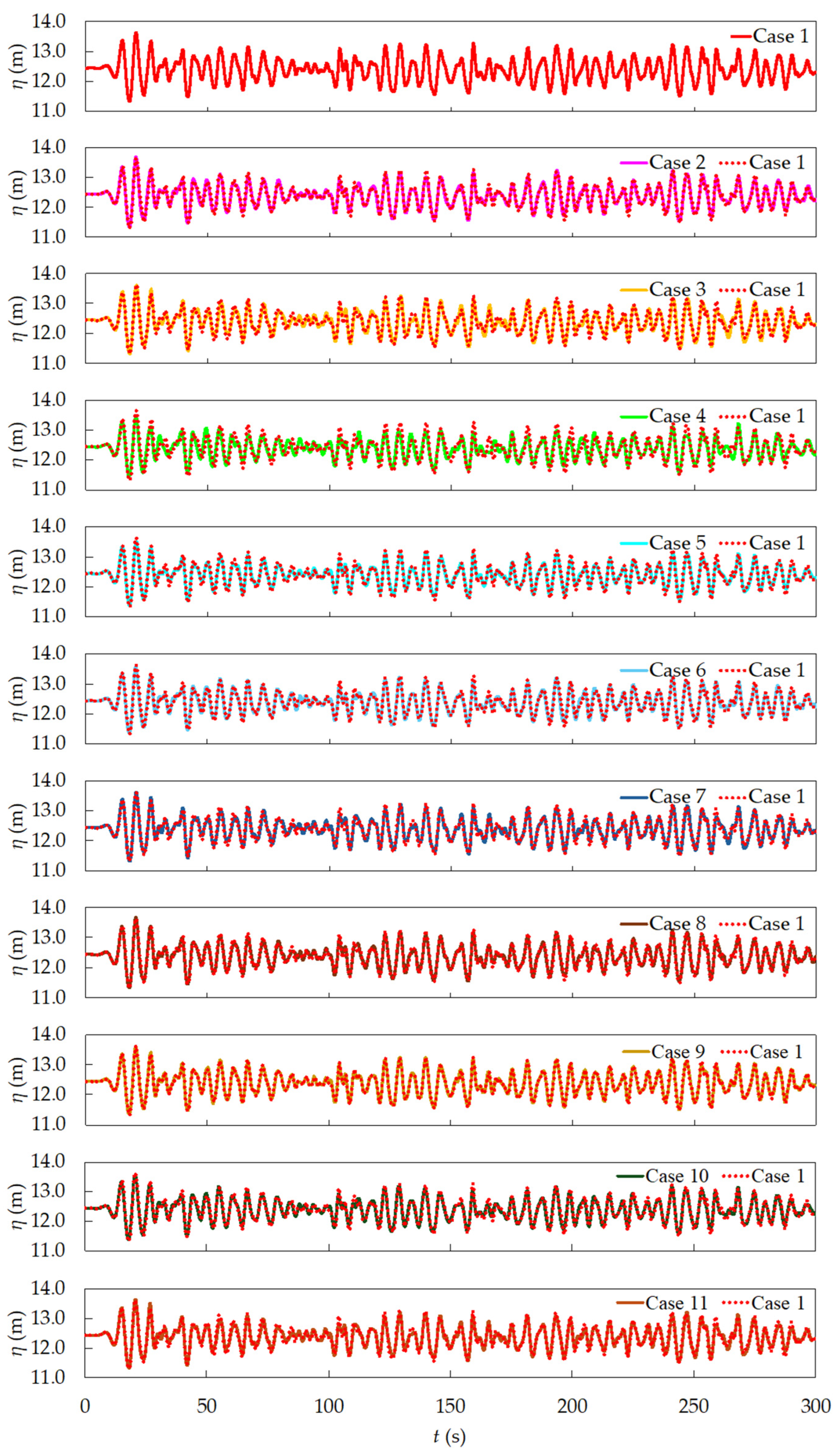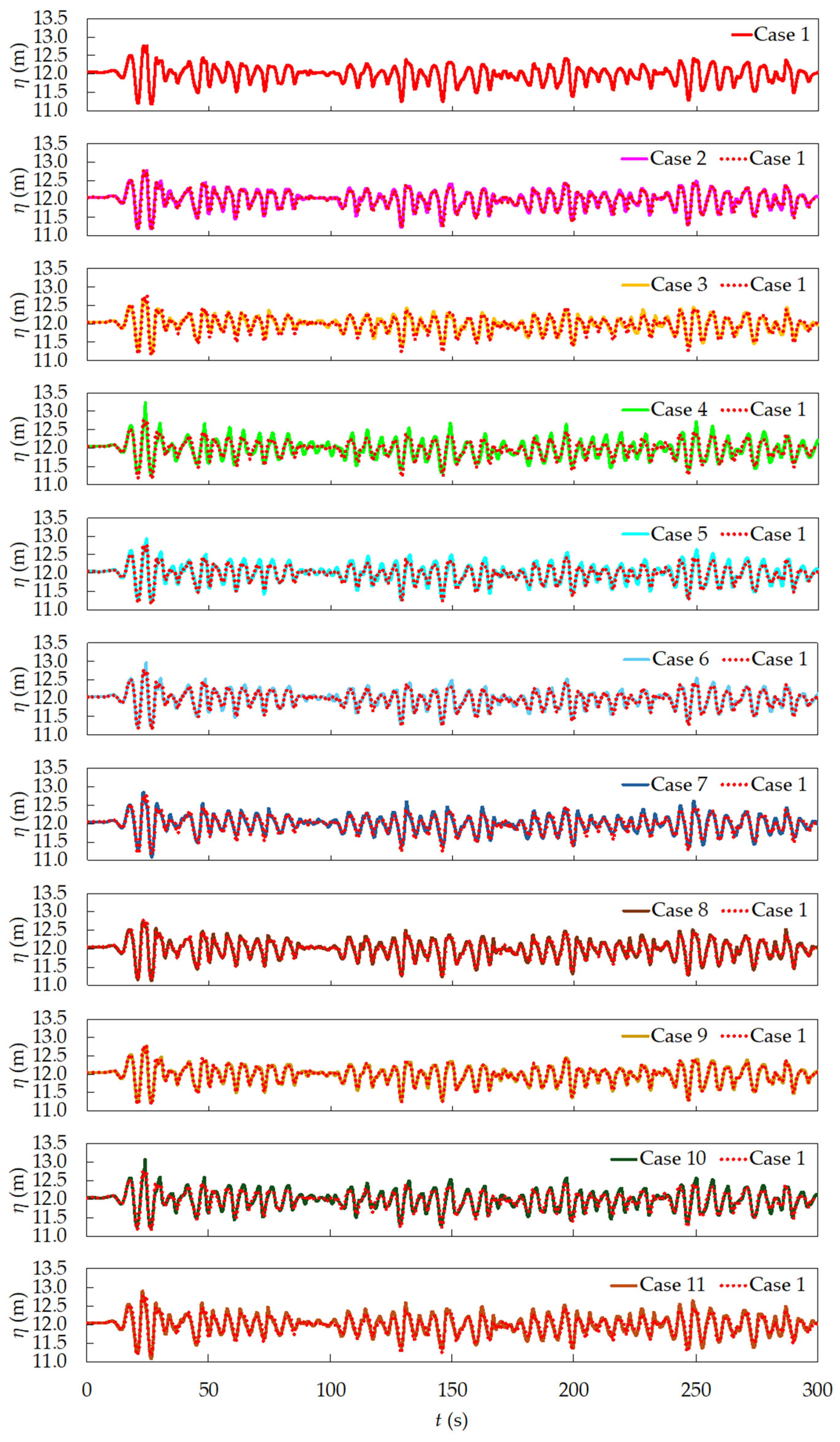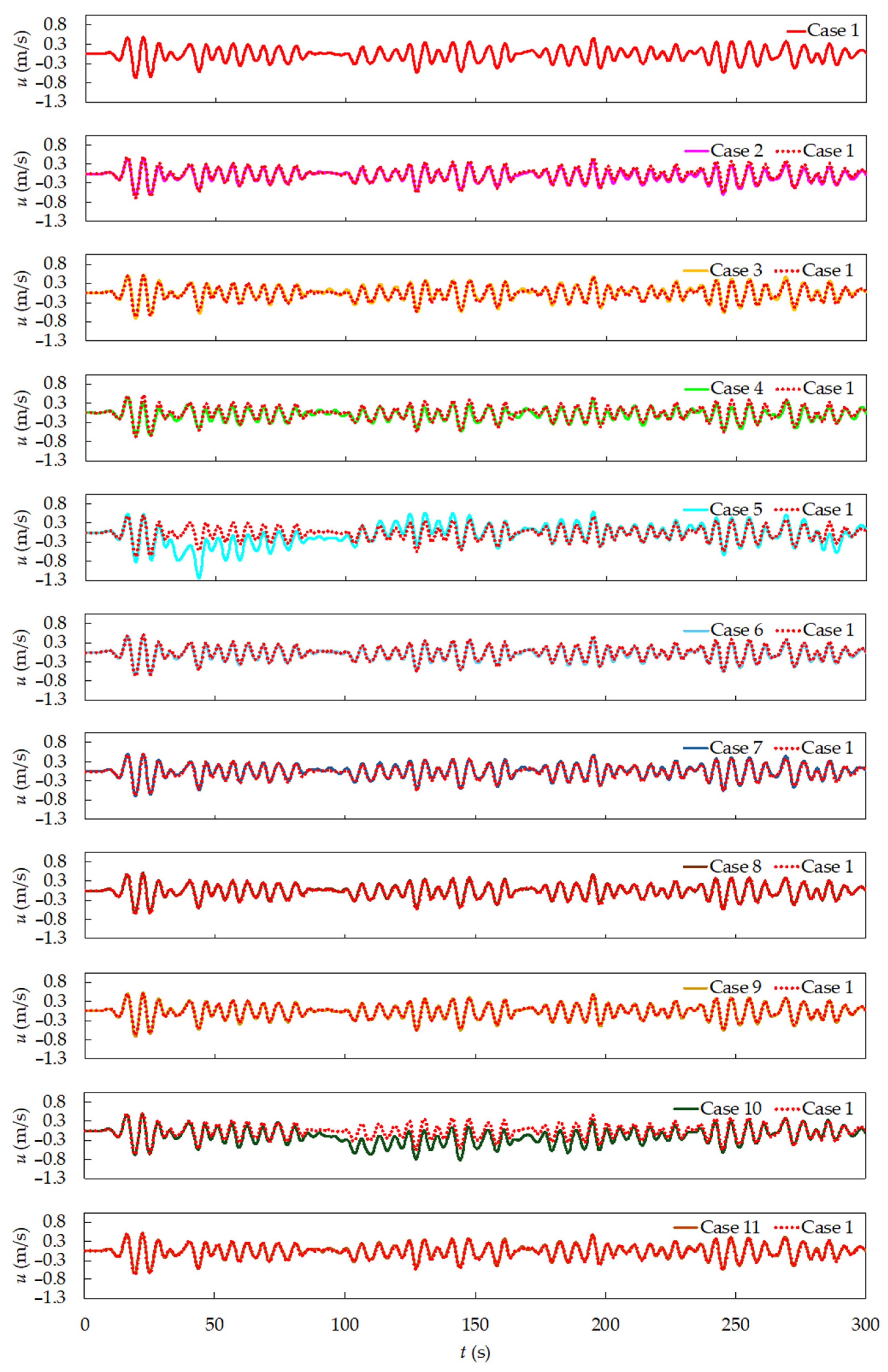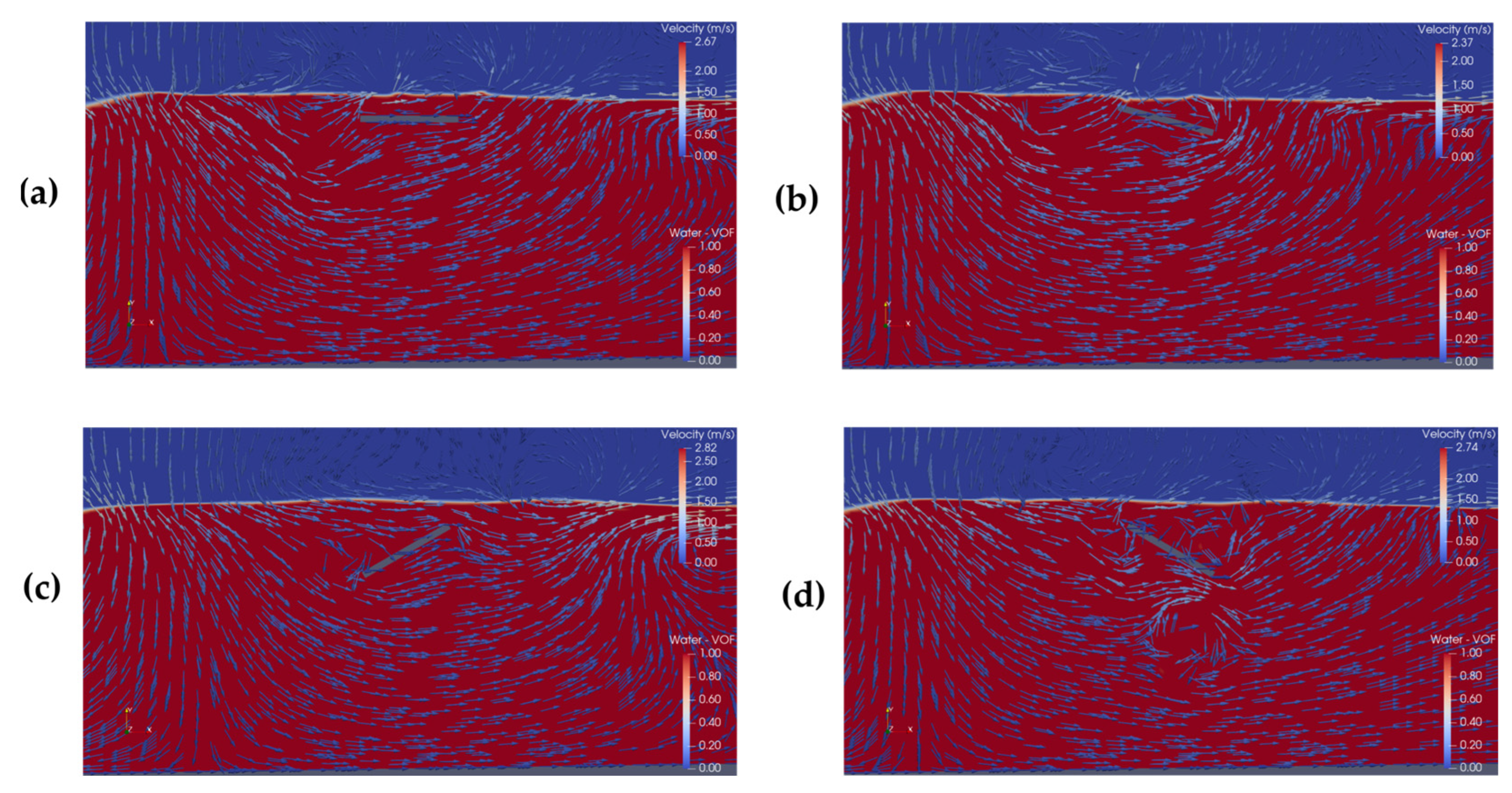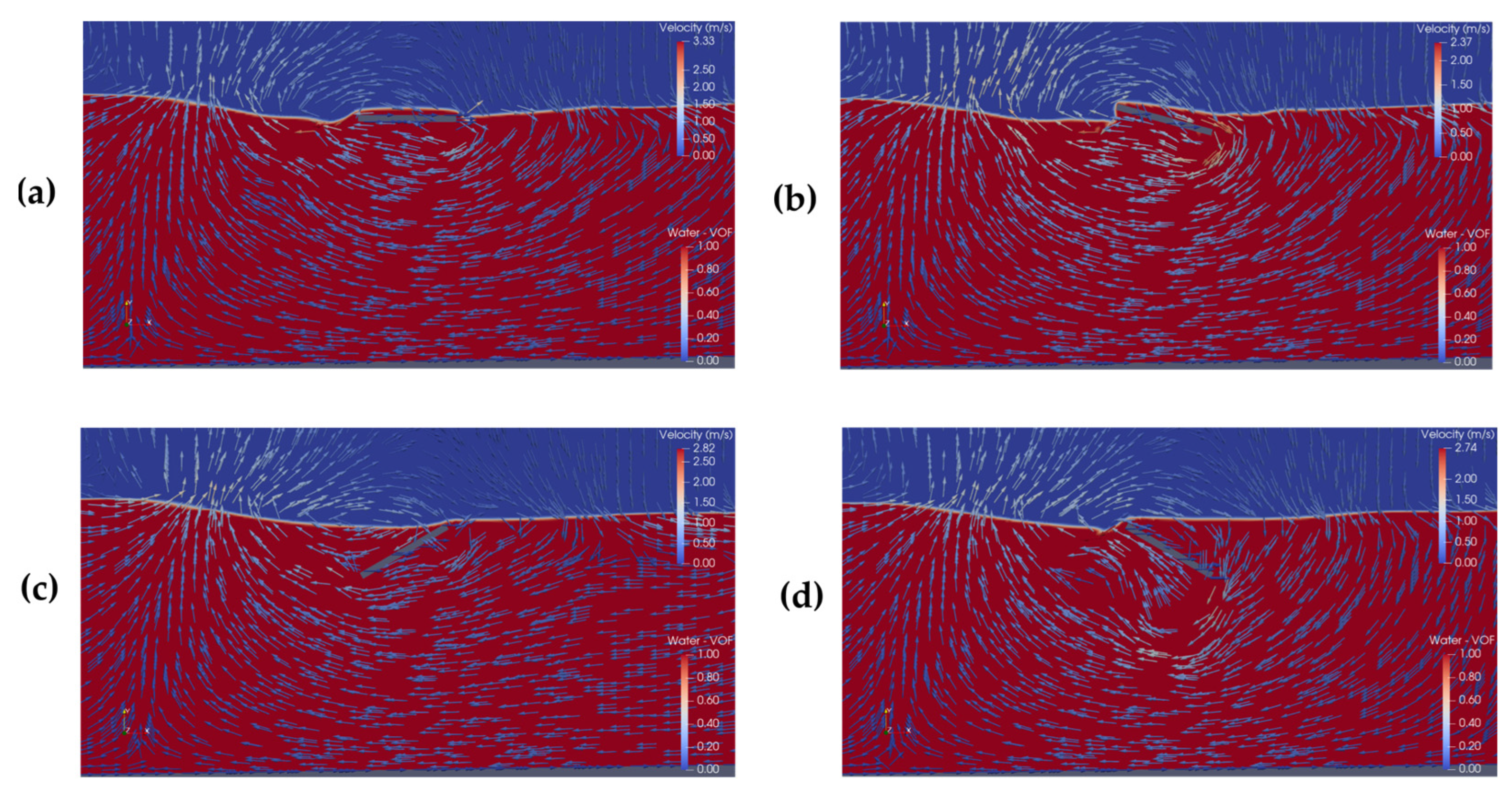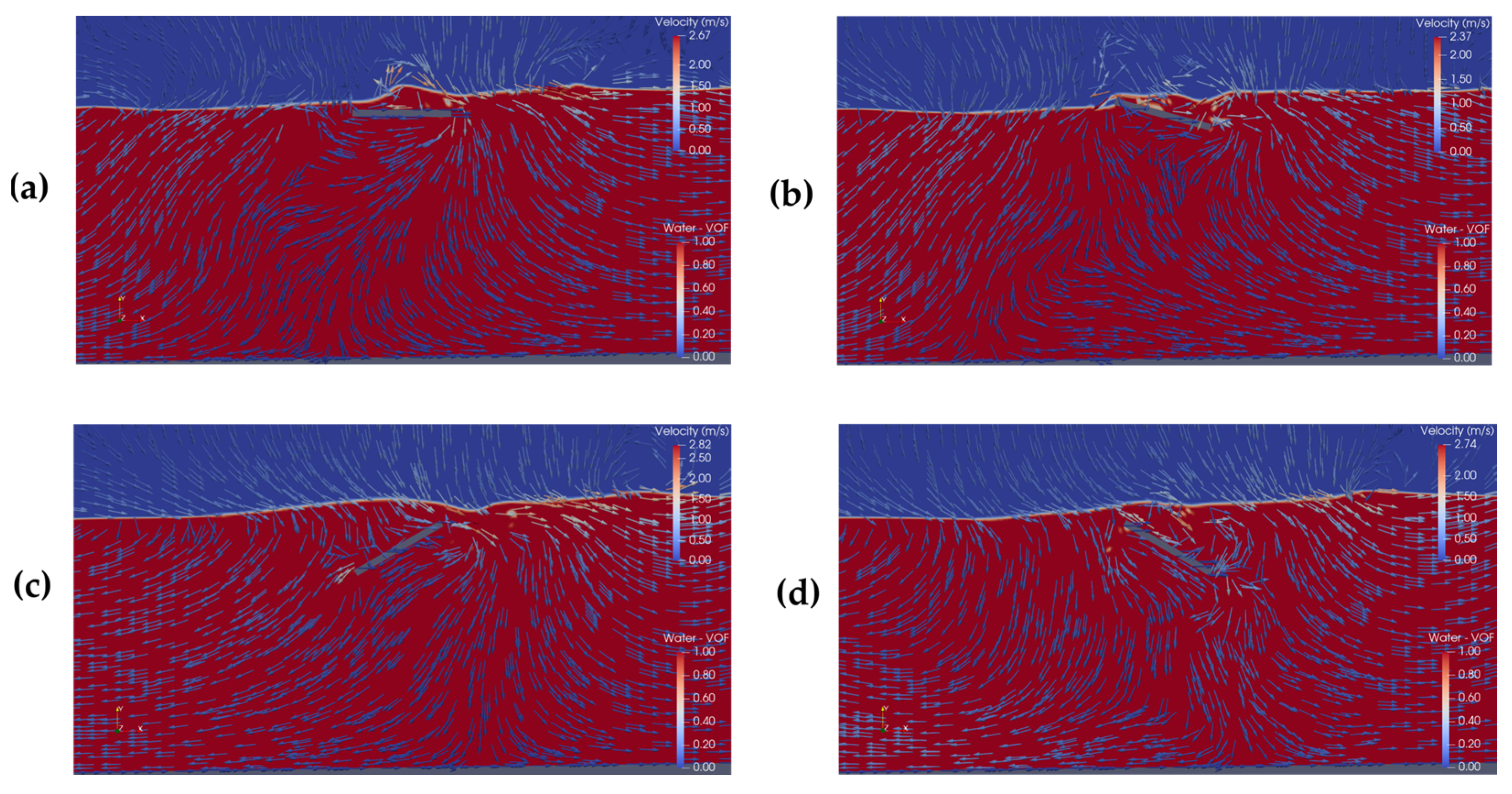3.3. Analysis of Cases 1–11 Under Representative Regular Wave Incidence
Firstly,
Figure 8,
Figure 9 and
Figure 10 present the results for Cases 2 to 11, which feature inclined configurations of the SP (see
Figure 1), as well as for Case 1 (see
Figure 1), used as the reference case for comparison. These results correspond to simulations with the representative regular waves of the coastal region of the Rio Grande. To allow a direct comparison between each inclined geometry and the reference case, the results of Cases 2 to 11 are plotted together with Case 1.
In
Figure 8, it can be observed that wave reflection on the plate affected the free surface elevation upstream. As the inclination varied, this reflection also changed, influencing the results. This effect is more pronounced here than in a previous study by [
48], due to the different wave characteristics. In the present study, the waves are higher but have shorter wavelengths, which enhances the influence of the plate’s inclination in the upstream region. Cases 8 and 9 showed the smallest differences compared to Case 1, which is expected due to their specific geometry, where the flow from left to right still impacts the same section without inclination. However, this effect is not so relevant to the objectives of this work, which are to reduce the free surface elevation downstream (acting as a BW) and to increase the axial velocity beneath the SP (acting as a WEC).
In
Figure 9, it can be observed that the inclination of the plate negatively affected its performance as a BW, since Case 1 presents a lower wave amplitude compared to the inclined cases, especially Cases 5 and 11. This behavior also contrasts with the previous study of [
48], in which a slight reduction in the free surface elevation was observed for some of these cases.
Still considering
Figure 9, it is worth noting that the lower average recorded by the downstream probe (approximately 12 m, compared to around 12.5 m upstream) is due to the presence of the bathymetry, which causes the channel bed elevation to vary with position. Since the probe measures the distance from the bottom to the free surface, the recorded value also changes according to the longitudinal position in the channel.
From
Figure 10, it is possible to observe a greater amplitude in the axial velocity of the inclined cases, primarily caused by the flow redirection due to the plate’s inclination from the region where the plate is inserted (
hp) toward the zone of interest (
hp/2), where the probe is placed.
Additionally, Case 5 (see
Figure 10) exhibited an oscillation in its variation axis, with negative values occurring between 100 and 200 s. This behavior can be explained by the 30° clockwise inclination adopted for this geometric configuration, which tends to redirect part of the aforementioned flow toward a region downstream of the numerical probe 3.
Although
Figure 8,
Figure 9 and
Figure 10 provide a good qualitative understanding of how the SP’s performance varies with inclination, this analysis still lacks clearer comparison parameters to better understand the influence of the plate’s geometric configurations on its hydrodynamic behavior, i.e., a quantitative evaluation. This justifies the use of a mathematical method proposed, see Equation (13), to obtain direct values that relate the efficiency of the investigated inclined cases to that of the reference case.
Therefore, a quantitative evaluation is fundamental for a more accurate assessment. Accordingly,
Table 5 presents the integrals
Iηd,
Iηu, and
Iu, calculated from the curves in
Figure 8,
Figure 9 and
Figure 10. It also includes the ratios of these values, indicating how much more or less efficient each configuration was as a BW and as a WEC device, and how much energy the specific case has attenuated.
By using the integral ratios
Iηd1/
Iηdi in
Table 5, the comparison of the results with Case 1 becomes simpler, more precise, and more direct. As it was already observed qualitatively, all inclined cases under regular wave conditions performed worse as BW devices compared to the reference, with ratios lower than 1. Case 11 shows 45.9% lower efficiency, and Case 5 shows 42.63% lower efficiency.
However, this relative efficiency does not take into account that the incident wave at the upstream probe (Iηui) had a greater magnitude. By analyzing the ratio Iηui/Iηdi, it becomes clear that the relative lower efficiency of the regular wave cases as BW devices does not necessarily indicate failure to perform this functionality, but rather that the incoming wave energy was higher. This ratio shows that, despite being less efficient than Case 1, all SP configurations under regular waves were still able to effectively reduce wave energy along the domain. Notably, Case 6 even achieved a slightly greater wave energy reduction than Case 1, highlighting its potential as an effective BW configuration under the tested conditions.
Apart from that, considering the ratios
Iui/
Iu1 in
Table 5, several configurations (Cases 3, 5, 7, 8, 9, and 11) demonstrated relatively superior performance as WEC devices, with Case 3 achieving 23.16% higher efficiency and Case 5 reaching an increase of 41.48% compared to the horizontal SP reference. These findings quantitatively support the idea that plate inclination can enhance the WEC function, even though it compromises BW performance under the tested conditions.
Furthermore, a trend was observed in the results, where cases with clockwise inclination (Cases 3, 5, 7, 9, and 11) tend to exhibit superior performance as WEC devices. This behavior is directly influenced by the redirection of the flow passing by the plate toward the region where the probe is located, as previously mentioned.
After that, although the ratio Iηui/Iηdi yields a more direct value for evaluating each case’s efficiency as a BW, the variation in Iηui values indicates that the device’s presence is also affecting this upstream reference. Therefore, in order to perform a comparison using a reference unaffected by the SP’s presence, an additional case without the SP (Case wSP) was simulated, and the downstream probe was monitored for comparison as a BW.
The downstream integral with regular wave generation for the case without the plate (
IηdwSP) was calculated, yielding a value of 77.7410 m·s. This value represents the area under the downstream probe curve without interference from the SP, allowing each case’s integral to be compared against it to assess the actual and direct impact of each SP configuration on the downstream probe. These results are presented in
Table 6, where the expression (1 −
Iηi/
IηwSP)·100 indicates the percentage by which the downstream probe area was reduced due to the insertion of the SP, thus providing a direct measure of the device’s efficiency as a BW.
From the analysis of
Table 6, it is possible to observe that Case 1 performed the best as a BW under regular wave conditions, reducing the area at the downstream probe by 58.84%. Nevertheless, all inclined cases contributed to the reduction in this area, with Case 6 achieving a 53.96% reduction and Case 9, a 51.94% reduction. It is also evident that Case 11 was indeed the least effective, with only a 23.92% reduction.
Finally, one can note that the results obtained in the present work due to the incidence of the representative regular waves are consistent with recent findings by [
49], who investigated the hydrodynamic behavior of inclined plates under regular wave action. Their study revealed that resonance phenomena associated with fluid wedges above inclined plates induce significant hydrodynamic loads, particularly at low inclination angles, where Helmholtz-like resonance tends to occur. This mechanism helps explain the lower BW efficiency observed in some inclined configurations, as such resonance can amplify local surface elevations and reduce the damping effect of the plate. On the other hand, as the inclination increases, the interaction between the wave and the device geometry likely promotes flow acceleration and vortex shedding beneath the SP, increasing axial velocity fluctuations and favoring energy conversion. This trade-off aligns with the trends observed here, where WEC performance improves with inclination, while BW efficiency decreases. These findings emphasize the relevance of geometric features, such as inclination angle and rotation direction, in shaping wave–structure interactions through mechanisms like partial reflection, nonlinear flow separation, and flow redirection.
3.4. Analysis of Cases 1–11 Under Realistic Irregular Wave Incidence
Following the same approach used for the representative regular wave results,
Figure 11,
Figure 12 and
Figure 13 present the downstream free surface elevation of the SP, upstream free surface elevation of the SP, and axial water flow velocity beneath the SP, respectively, for Cases 2 to 11, with Case 1 used as the reference.
It is noticeable in
Figure 11 that, similar to the regular waves, the inclinations in each case caused different wave reflections on the plate under the upstream probe. As mentioned in the previous section, these variations are not so significant for the main objective of this study. However, it is important to present the hydrodynamic behavior that occurred. Furthermore, the focus remains on assessing the effects of inclination on the downstream free surface elevation and axial velocity, which are directly related to the device’s performance as a BW and WEC.
Figure 12 indicates that although the realistic sea behavior makes qualitative comparison through the graphs more challenging, it is still possible to observe that the inclined cases remain relatively less efficient as BWs, showing higher free surface elevation amplitudes than the reference case (Case 1). This trend suggests that, in a general way, under the irregular wave conditions tested in this study and for the specific plate geometry analyzed, the inclined configurations tend to be less effective in attenuating wave energy in the downstream region when compared to the SHP reference case.
From
Figure 13, some cases exhibit a clearer superiority as a WEC under irregular wave conditions, particularly Cases 5 and 10. However, several other cases also demonstrate improved performance compared to the reference, indicating that the inclination of the plate can enhance the device’s ability to extract the wave energy. This suggests that, when properly configured, the geometric modification of the SP not only influences the flow dynamics but can also significantly contribute to improving its performance as a WEC across different wave conditions.
Furthermore, the shift in the oscillation axis of axial velocity was also observed in the irregular wave generation study for Cases 5 and 10 (see
Figure 13). In Case 5, this behavior occurred for the same reason previously mentioned when the representative regular waves were considered (see
Figure 10), i.e., due to the clockwise inclination that redirects part of the flow. While in Case 10, the shift was mainly caused by the promotion of flow recirculation induced by the plate’s geometry (see
Figure 1).
As performed in the analysis of the representative regular waves, a quantification of the magnitude of the surface elevation downstream and upstream of the SP and of the axial water flow velocity beneath the SP was performed in
Table 6, allowing the comparison of inclined cases with the reference case and an estimate of wave attenuation considering the upstream and downstream irregular wave magnitudes.
Table 7 indicates by the ratios
Iηd1/
Iηdi that although most cases showed reduced relative efficiency as BW devices when inclined, Case 3 demonstrated a 5.13% higher efficiency than Case 1. This highlights the importance of understanding the realistic sea behavior in the region where the SP will be deployed. Under regular wave conditions, the same case showed a 36.24% lower efficiency as a BW (see
Table 5) in comparison to Case 1, emphasizing the limitations of relying solely on idealized wave generation.
Considering also the incident waves measured at the upstream probe, from ratios
Iηui/
Iηdi from
Table 7 it is evident that the inclined configurations are still capable of acting as effective breakwaters under irregular wave conditions, attenuating a significant portion of the incoming wave energy. Corroborating the previous analysis, Case 3 stands out with superior performance compared to the other cases.
Still taking into account
Table 7 and analyzing
Iui/
Iu1, for WEC performance, the previously observed trend in the regular wave study (see
Table 5) is reinforced: the cases with clockwise inclination (3, 5, 7, and 9) achieved higher relative efficiency. Among them, Case 5 stood out, showing 50.14% greater efficiency compared to Case 1, mainly due to the shift in the axis of velocity variation.
To identify whether this result was solely due to the shift in the velocity variation axis, Iu1 and Iu5 were recalculated by disregarding the simulation time before 120 s for both cases. The resulting values were 27.2121 m for Iu1 and 33.1134 m for Iu5, yielding an integral ratio of 1.2169. In other words, even after removing the time interval in which the axis shift occurred, Case 5 remains 21.69% relatively more efficient as a WEC.
Moreover, this study used an extra case without the SP was also carried out for the incidence of realistic irregular waves, applying the expression (1 − Iηdi/IηwSP)·100 to calculate the percentage reduction in the downstream area for each case. The calculated value for IηwSP in this scenario was 75.2588 m·s.
From the analysis of
Table 8, it can be observed that Case 3 was the most effective, achieving a 30.84% reduction in the downstream area, while Case 4 was the least effective, with only a 13.84% reduction. Nevertheless, all cases led to a reduction in this area and hence can be considered effective as BWs.
Alongside the integrals
Iηd,
Iηu, and
Iu obtained from probes 1, 2, and 3 (see
Table 7 and
Table 8), the ParaView (version 5.13.3) software was employed to visualize the velocity field through vector representation along the wave flume at 40.23 s, 43.61 s, and 249.77 s (
Figure 14,
Figure 15 and
Figure 16, respectively), with red/blue indicating water/air phases. These specific time instants were selected to provide insight into the hydrodynamic behavior of each selected SP case throughout the numerical simulation. The analyzed cases include Case 1 (the SHP, adopted as reference), Case 3 (the one with the best BW), Case 4 (the one with the worst BW and WEC), and Case 5 (the one with the best WEC). The time 40.23 s was chosen because it corresponds to a wave crest in all cases, although Case 5 is still on the negative axis. The time 43.61 s was selected because it corresponds to the maximum axial velocity in Case 5, which is significantly higher than in the other cases, and all configurations are within a wave trough. Finally, the time 249.77 s was chosen to capture a transition from the positive to the negative axis, corresponding to the moment when the axial velocity crosses zero.
In
Figure 14, a left-to-right flow is observed in all analyzed cases, which corresponds to a location closer to the wave crests in the simulation (see
Figure 13). However, for Case 5, it is possible to understand the reason behind its negative axial velocity values at this same instant (see
Figure 13). Due to the inclination of the SP (especially because the incident flow is deflected downward toward the region beneath the plate), a vortex forms near the probe location (
hp/2). This vortex causes a downward shift in the axial velocity axis, resulting in the observed negative values that persisted over the time interval from 30 s to 115 s.
In contrast, part of the reason behind the low efficiency of Case 4 as a WEC can also be identified. The inclination of the SP in this case causes the incident flow to be deflected upward, directing it away from the probe region and reducing the interaction between the flow and the probe. Furthermore, this upward deflection of the flow also causes an increase in velocity at the free surface, which worsens the device’s performance as a BW.
Regarding the high efficiency of Case 3 as a BW,
Figure 14 indicates that, although it shares the same flow deflection direction as Case 5, its plate is positioned higher in the domain. As a result, it was able to redirect part of the velocity present near the free surface downward, which effectively reduced the impact of the incident wave on the downstream probe, while also increasing the axial velocity at the probe located at
hp/2.
Additionally, it was observed that Cases 4 and 5, being positioned lower in the computational domain compared to the other cases, exhibited less impact on wave attenuation due to their greater distance from the free surface.
As expected, no flow redirection phenomena are observed in Case 1. In this configuration, the hydrodynamic impact of the SP is primarily governed by the reflection and transmission of the incident waves by the flat plate. Since there is no inclination, the interaction with the flow occurs uniformly across the plate surface, without inducing significant vertical velocity components or vortex structures in the probe region.
In
Figure 15, the velocity field shows a right-to-left flow direction, corresponding to a moment closer to the wave troughs in the axial velocity plots (see
Figure 13). In addition to the continued presence of the vortex beneath the SP, the superior performance of Case 5 as a WEC becomes even more evident. The velocity magnitude color scale highlights that the maximum velocity occurs precisely in the region where the probe is located, indicating that this configuration makes the most efficient use of the wave-induced flow in the channel.
In Case 4, although the flow direction at this instant would favor downward deflection beneath the SP, the flow is not redirected toward the probe region. Instead, it is diverted farther to the left within the channel. As a result, even though this geometric configuration has the potential to benefit from the negative direction of the axial velocity, such an effect is not observed. Consequently, Case 5 remains significantly more effective in terms of the WEC functionality of the SP.
The high efficiency of Case 3 as a BW is also more evident in
Figure 15, with clear wave attenuation observed on the right side of the plate. Additionally, it presents a velocity field behavior very similar to that of Case 5, although with lower intensity, which can be attributed to its smaller clockwise inclination.
Furthermore, although greater wave attenuation for the cases at 43.61 s can be observed through the white line visualization in the free surface region (the water–air mixture zone), Case 4 is clearly the one causing the least impact on the incident waves interacting with the SP.
Case 1, which serves as the reference in this study, exhibits a favorable performance as a BW by attenuating the wave on both sides of the plate without reducing its resistance near the free surface, and without obstructing or disturbing the flow beneath the SP. As a result, it produces a reasonably well-distributed velocity field in the WEC probe region, although it does not stand out as one of the best-performing cases in terms of WEC efficiency.
In
Figure 16, the velocity field points downward, representing a transition period where axial velocity values in the SP region change from positive to negative. The velocity fields of the four analyzed cases exhibit similar behavior at this time, with the region above the SP showing zones of water–air mixing and higher velocities compared to other analyzed times. Additionally, the velocity measured at the WEC probe region is approximately 0 m/s at this time instant.
Apart from that, the greater effectiveness of Cases 1 and 3 as BWs becomes evident, as these cases show the strongest disturbances near the free surface. The waves undergo greater interaction with the plate, resulting in a higher proportion of energy dissipation.
Conversely, Cases 4 and 5, positioned lower in the computational domain, were unable to generate disturbances of comparable magnitude and therefore had less impact on the free surface, resulting in lower BW efficiency.

